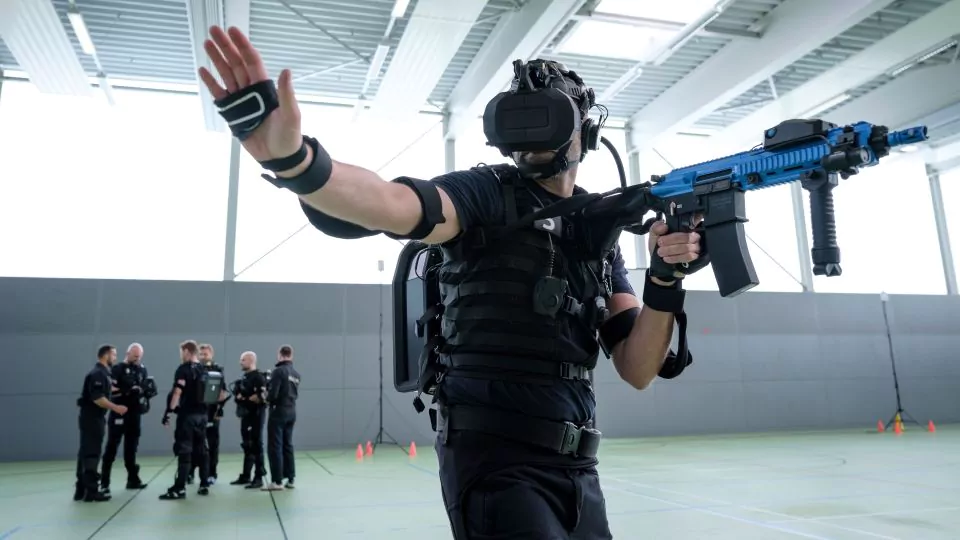Simulation training takes shape through a diverse range of tools, each offering unique advantages. Let's delve into this comprehensive training arsenal and explore the core principles behind each type of simulation solution. While this segment explores the various types of simulation solutions, Chapters 4 and 5 will provide a comprehensive guide on integrating and implementing these tools for optimal training effectiveness.

Physical Simulation Solutions
Physical simulation solutions offer a hands-on learning experience that utilizes realistic tools and materials. Envision soldiers honing close-quarters combat (CQB) within a simulated building constructed from Trango's modular systems, engaging an opposing force equipped with Simunitions. Similarly, picture a police officer sharpening their weapons handling skills with A.U.Fire's simulation kits, which realistically mimic injury effects by immobilizing limbs. Physical simulation systems allow trainees to experience the sights, sounds, and consequences of their actions in a safe and controlled environment. Physical simulation kits can be particularly valuable for practicing complex procedures, like close-quarters combat maneuvers or tactical entry techniques. The ability to utilize realistic equipment and experience the physical aspects of these procedures fosters muscle memory and builds confidence for real-world situations.

Hybrid Simulators
Marrying the physical world with the digital realm, hybrid simulators create highly realistic training environments for activities heavily reliant on specialized equipment. Think of a flight simulator, where a physical cockpit layout is seamlessly integrated with computer-generated visuals, allowing pilots to practice maneuvers in a realistic setting. Similarly, driving simulators can combine a physical car with virtual environments, enabling trainees to hone their skills under diverse driving conditions without ever leaving the training facility. These hybrid solutions offer an immersive and dynamic training experience for tasks requiring the use of complex equipment.

Computer Based Task Trainers
For focused skill development, computer-based task trainers offer a controlled and repeatable learning environment. Take, for instance, CRLT's The Incident. This program simulates various crisis scenarios for command elements and first responders. Within a "sandbox environment," participants can test their emergency response measures and action plans by running through a multitude of scenarios. This allows them to practice key processes and procedures, ultimately refining their mitigation plans for real-world emergencies. These task trainers often provide immediate feedback and performance metrics, enabling instructors to tailor training based on individual needs. Their focus on specific skills makes them ideal for repetitive practice and targeted skill development.

Projection-Based Simulators
Utilizing projectors and screens, these simulations create immersive training environments for a variety of purposes. Imagine soldiers honing their marksmanship skills with advanced simulation trainers like the Engagement Skills Trainer II (EST II), which provides a virtual range complete with realistic sights, sounds, and ballistic calculations. In law enforcement, projection-based simulations can be used to create realistic hostage situations, allowing officers to practice negotiation and tactical decision-making. By offering adaptable and scalable training scenarios, projection-based simulations cater to a wide range of training needs.

Virtual Reality
VR simulations create a fully immersive world where trainees can interact with virtual environments using specialized headsets and controllers. Imagine a law enforcement officer navigating a de-escalation scenario in a virtual environment, practicing communication and conflict resolution skills with simulated characters. VR simulations offer a high degree of realism and interactivity, allowing trainees to grapple with complex situations in a safe and controlled setting.

Augmented Reality
AR overlays digital elements onto the real world, creating a blended training environment. Imagine a team of soldiers navigating a CQB training facility. Through specialized headsets, they see not just the physical walls and doorways, but a virtual overlay depicting enemy positions, potential threats, and even teammate locations. AR simulations seamlessly integrate virtual challenges with a familiar training environment, allowing trainees to practice skills using their actual tools.
This diverse array of simulation solutions empowers training programs to cater to a wide range of needs and learning styles. From the focused practice offered by task trainers to the immersive worlds of VR and AR, each type of simulation plays a crucial role in shaping a more skilled and prepared force.
Find me on LinkedIn
Email me at
.png)





Comments